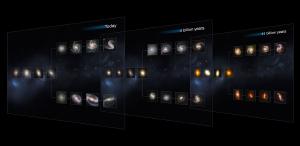Post
CANDELS in the Dark
21 August 2013
 NASA, ESA, M. Kornmesser
NASA, ESA, M. KornmesserIf you look at different galaxies in the universe, you begin to notice that they seem to fall into some broad types. Edwin Hubble was the first to categorize galaxies into different types, and he divided them into ellipticals, spirals and irregulars. He then further broke these categories into subgroups, and arranged them into what is now known as Hubble’s Tuning Fork diagram.
When Hubble first proposed the tuning fork diagram, there were some who suggested this might be indicative of the evolution of galaxies, with irregulars collapsing into ellipticals, and ellipticals gradually flattening into spirals. This type of galactic evolution doesn’t work. Observations of more distant (and therefore older) galaxies show they aren’t primarily irregular or elliptical. But this raises a broader question about galactic evolution, specifically about how the tuning fork morphology for galaxies evolved over time. For this we have the Cosmic Assembly Near-infrared Deep Extragalactic Legacy Survey (CANDELS).
The CANDELS survey used data from the Hubble Space Telescope to survey a range of galaxies from the closest to more than 11 billion light years away. Observing galaxies at increasing distances also means observing galaxies as they were in the past. So CANDELS looked at galaxies over an 11 billion year period. Grouping galaxies by age, they could then be assembled into the Hubble morphology. This allows us to look at how the tuning fork diagram changed over time.
The result can be seen in the image above. What we find is that the diagram has remained fairly unchanged for the last 11 billion years. The most distant galaxies are still in the process of forming, but they already have a structure similar to later galaxies of their type. In astronomer-speak, it seems galaxies matured early on.
But this image is a bit misleading. Since it is a publicity image meant to emphasize the point of the findings. The distant galaxies in the image look like modern nearby galaxies, and they are remarkably clear for being 11 billion light years away. That’s not quite how they actually look.
If you want to see how they really look, and learn more about the details about CANDELS, you can find that here.